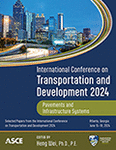Influence of Reclaimed Asphalt Pavement in Hot Mix Asphalt
Publication: International Conference on Transportation and Development 2024
ABSTRACT
The application of reclaimed asphalt pavement (RAP) materials in the pavement construction industry has been on an upward trajectory due to cost considerations and the need for sustainability. The scarcity of road construction materials may be effectively addressed by integrating RAP in developing countries like Bangladesh. This paper provides a comprehensive and insightful evaluation of RAP utilization alongside natural aggregate for road construction purposes. Various recycling processes have been applied across the world, and this study emphasizes the hot mix recycling method and its potential use for the construction of new pavement layers. In this study, recycled aggregates from six different locations show slightly downgraded properties but still fall within specified limits. Consequently, recovered bitumen from the rotary evaporator performs satisfactorily in rheological testing, although oxidation and aging have caused variations in some of its properties. This paper determines the influence of using different RAP percentages (0%, 30%, 50%, 70%, and 100%) and bitumen content (0%−6.5%) in hot mix asphalt (HMA) on the Marshall test results. Incorporating 70% reclaimed asphalt pavement (RAP) yields the greatest strength, while concurrently requiring an addition of bitumen content of 0.8%−1.5%. The research concludes that recycled pavement materials can produce stable and durable bituminous mixes, contributing to sustainable infrastructure development.
Get full access to this chapter
View all available purchase options and get full access to this chapter.
REFERENCES
AASHTO. AASHTO R 35-04, Superpave Volumetric Design for Hot Mix Asphalt, American Association of State Highway and Transportation Officials, Washington D.C., 2008.
AASHTO. AASHTO, M 323-13. (2013). Standard specification for Superpave volumetric mix design. ASHTO Provisional Procedure, Washington, D.C.
ASTM. Standard Test Method for Quantitative Extraction and Recovery of Asphalt Binder from Asphalt Mixtures. ASTM D 6847. West Conshohocken, PA, USA, 2002.
ASTM. ASTM D5404. Standard Practice for Recovery of Asphalt from Solution Using the Rotary Evaporator, Annual Book of ASTM Standards, Road and Paving Materials; Vehicle-Pavement Systems, 04.03, West Conshohocken, Pennsylvania (1993).
Brown, E. R., Kandhal, P. S., Roberts, F. L., Kim R., Lee, D. Y., and Kennedy, T. W. (2009). Hot mix asphalt materials, mixture design and construction. Third Edition, NAPA Research and Education Foundation.
Copeland, A. (2011). Reclaimed asphalt pavement in asphalt mixtures: state of the practice.
Etxeberria, M., Pacheco, C., Meneses, J., and Berridi, I. (2010). “Properties of concrete using metallurgical industrial by-products as aggregates.” Construction and Building Materials, 24(9), 1594–1600.
FHWA (Federal Highway Administration). (2012). Performance testing for Superpave and structural validation. Chapter 6.
FHWA (Federal Highway Administration). (2015). Asphalt pavement recycling with reclaimed asphalt pavement (RAP). Retrieved from http://www.fhwa.dot.gov/paveemnt/recycling/index.cfm.
FHWA (Federal Highway Administration). “Reclaimed Asphalt Pavement in Asphalt Mixtures: State of the Practice,”. FHWA, McLean, Virginia, 2011. Retrieved from https://www.fhwa.dot.gov/publications/research/infrastructure/pavements/11021/11021.pdf.
IRC (Indian Road Congress). (2015a). Code of Practice for Maintenance of Bituminous Road Surfaces. IRC: 82. Indian Road Congress (IRC), New Delhi.
IRC (Indian Road Congress). (2015b). Recommended Practice for Recycling of Bituminous Pavements. IRC: 120. Indian Road Congress (IRC), New Delhi.
Islam, M. R., Hossain, M. I., Iqbal, M. B., Rahman, M., Sarker, A., and Noor, C. A. (2019). Utilizing fly ash to improve subgrade properties in Bangladesh.” In Airfield and Highway Pavements 2019: Testing and Characterization of Pavement Materials (pp. 522–530). Reston, VA: American Society of Civil Engineers.
JTG F 40, Technical specification for the construction of highway asphalt pavement, Ministry of Transport of the People’s Republic of China, 2004.
MS 20, Asphalt hot-mix recycling, The Asphalt Institute, 7th ed., 2014.
Mikhailenko, P., Ataeian, P., and Baaj, H. (2019). Extraction and recovery of asphalt binder: a literature review. International Journal of Pavement Research and Technology, 13(1), 20–31. https://doi.org/10.1007/s42947-019-0081-5
, “Information Series 139: High RAP Asphalt Pavements: Japan Practice — Lessons Learned”, National Asphalt Pavement Association, 2015. Retrieved from https://www.asphaltpavement.org/uploads/documents/EngineeringPubs/IS139_High_RAP_Asphalt_Pavements_Japan_Practice-lr.pdf.
Rahaman, M. O., Mostafa, T., and Mamun, M. A. A. (2020). “Scarcity of Road Construction Materials in Bangladesh: Exploring Pavement Recycling Option as a Solution.” International Journal of Structural and Civil Engineering Research, 25–33. <https://doi.org/10.18178/ijscer.9.1.25-33>.
Rahaman, M. O., Sarker, A., Mamun, M. A. A., Hasi, A. D., and Amin, M. A. (2023). Evaluation of Steel Slag as a Road Construction Material. In Airfield and Highway Pavements 2023. American Society of Civil Engineers (ASCE). <https://doi.org/10.1061/9780784484906.007>.
Rahaman, M. O., Roksana, K., and Mukit, M. (2020). “Spatial and temporal trends of air quality around Dhaka city: A GIS Approach.” Advances in Applied Science Research, vol.11, no. 4:8
Sarker, A., Iqbal, M. B., Rahman, M. M., Rahman, M. A., and Islam, M. R. (2018). “Optimum Fly Ash to Increase the Strength of Subgrade.” Retrieved from <http://103.99.128.19:8080/xmlui/handle/123456789/263>.
Superpave. (2005). Superpave performance by design final report of the TRB Superpave committee. Transportation Research Board (ISBN 0-309-09414-3)
Transportation Research Circular Number E-C188. “Application of Reclaimed Asphalt Pavement and Recycled Asphalt Shingles in Hot-Mix Asphalt”, Transportation Research Board, 2014, Retrieved from https://onlinepubs.trb.org/onlinepubs/circulars/ec188.pdf.
Ziari, H., Moniri, A., and Norouzi, N. “The effect of nanoclay as bitumen modifier on the rutting performance of asphalt mixtures containing high content of rejuvenated reclaimed asphalt pavement”, Petroleum Science and Technology, 37(17), 1946–1951, 2019.
Information & Authors
Information
Published In
History
Published online: Jun 13, 2024
Authors
Metrics & Citations
Metrics
Citations
Download citation
If you have the appropriate software installed, you can download article citation data to the citation manager of your choice. Simply select your manager software from the list below and click Download.
